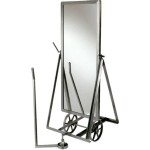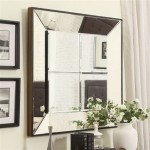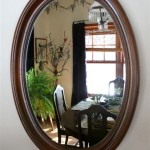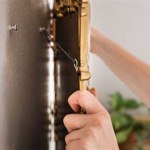How to Glue a Bathroom Mirror to the Wall
Installing a bathroom mirror can enhance the space's functionality and aesthetics. While traditional methods involve screws and nails, adhering a mirror directly to the wall using glue can be a cleaner and more discreet option. This method is particularly suitable for smaller mirrors or those located in moisture-prone environments like bathrooms. However, it's crucial to select the right glue and follow proper application techniques for a secure and long-lasting installation.
Choosing the Appropriate Adhesive
The success of gluing a bathroom mirror to the wall hinges on selecting the correct adhesive. Not all glues are created equal, and some may not be strong enough to hold the weight of a mirror, while others might react poorly with moisture or leave behind unsightly residue. Here's a breakdown of commonly used adhesives and their suitability for mirror installation:
- Construction Adhesive: Construction adhesive is known for its high bonding strength and resistance to moisture. This makes it a viable option for bathroom mirror installation, especially for heavier mirrors. However, ensure the adhesive is specifically formulated for use with mirrors and non-porous surfaces.
- Silicone Sealant: Silicone sealant is a flexible adhesive that also exhibits excellent resistance to moisture. It's often preferred for its ability to create a waterproof seal and can be applied in thin layers, making it suitable for smaller mirrors. However, its adhesion strength might not be as strong as construction adhesive.
- Mirror Adhesive: Mirror adhesive is specifically designed for bonding mirrors to various surfaces. It typically offers a high bond strength, moisture resistance, and is formulated to be readily available for cleanup. This makes it a highly recommended option for bathroom mirror installation.
When choosing an adhesive, consider the mirror's weight, the surface it will be mounted on, and the desired level of moisture resistance. Always consult the manufacturer's instructions and warnings before application.
Preparing the Wall and Mirror
Proper preparation is essential for a successful and long-lasting mirror installation. This involves cleaning and prepping both the wall and the mirror to ensure a smooth and sturdy bond.
- Clean the Wall: Thoroughly clean the wall surface where the mirror will be installed. Remove any dust, dirt, grease, or debris using a damp cloth and a mild detergent. The surface should be completely dry before applying adhesive.
- Prime the Wall: Consider applying a bonding primer if the wall surface is not smooth or porous. A primer creates a better adhesion surface, ensuring the glue adheres firmly to the wall. Allow the primer to dry completely before proceeding.
- Clean the Mirror: Clean the back of the mirror with a glass cleaner and a microfiber cloth. Ensure the surface is completely dry and free of any remnants of the cleaning solution. This step helps the glue adhere properly to the mirror surface.
By diligently preparing the wall and mirror surfaces, you create a foundation for a secure and long-lasting bond.
Applying the Adhesive and Installing the Mirror
Once the wall and mirror are adequately prepared, apply the adhesive according to the manufacturer's instructions. The application process might vary depending on the type of adhesive used, but in general, these steps are followed:
- Apply Adhesive to the Mirror: Apply a thin, even layer of adhesive to the back of the mirror, avoiding the edges. Make sure to cover the entire surface where the mirror will be placed against the wall. Use a notched trowel or a spreader to create a thin and consistent layer.
- Position the Mirror: Carefully position the mirror on the wall, ensuring it is level and in the desired location. Use a spirit level to verify the mirror's alignment. Gently press the mirror against the wall, applying even pressure to ensure a firm bond.
- Secure the Mirror: Once the mirror is positioned correctly, apply additional pressure or use adhesive tape to secure it in place for a certain amount of time, as specified by the manufacturer's instructions. This allows the glue to start setting and achieve initial adhesion.
After applying the adhesive and securing the mirror, refrain from touching or moving the mirror for a period of time, usually 24 to 48 hours. This allows the adhesive to cure fully, achieving optimal bonding strength.

How To Remove A Mirror Glued The Wall Forbes Home

How To Glue A Mirror Bathroom Wall Tiktok Search

Removing A Glued On Mirror From Wall

How To Remove A Glued Bathroom Mirror From The Wall

How To Install A Mirror Without Frame Merrypad

White Decorative Adhesive Bathroom Mirror Wall For Home

How To Remove A Glued Bathroom Mirror From The Wall

Bathroom Mirror Wall1727 Packaging Type Plastic Shape Oval

Buy Plexus Oval Shape Adhesive Mirror Sticker For Wall On Tiles Bathroom Bedroom Living Room Basin Stickers Unbreakable Plastic 30 20 Clear Unframed

2pcs Bathroom Mirror Decorative Wall Self Adhesive 20x20cm Hd Square Glass Full Length For Bedroom Living Room Door Lazada Ph








